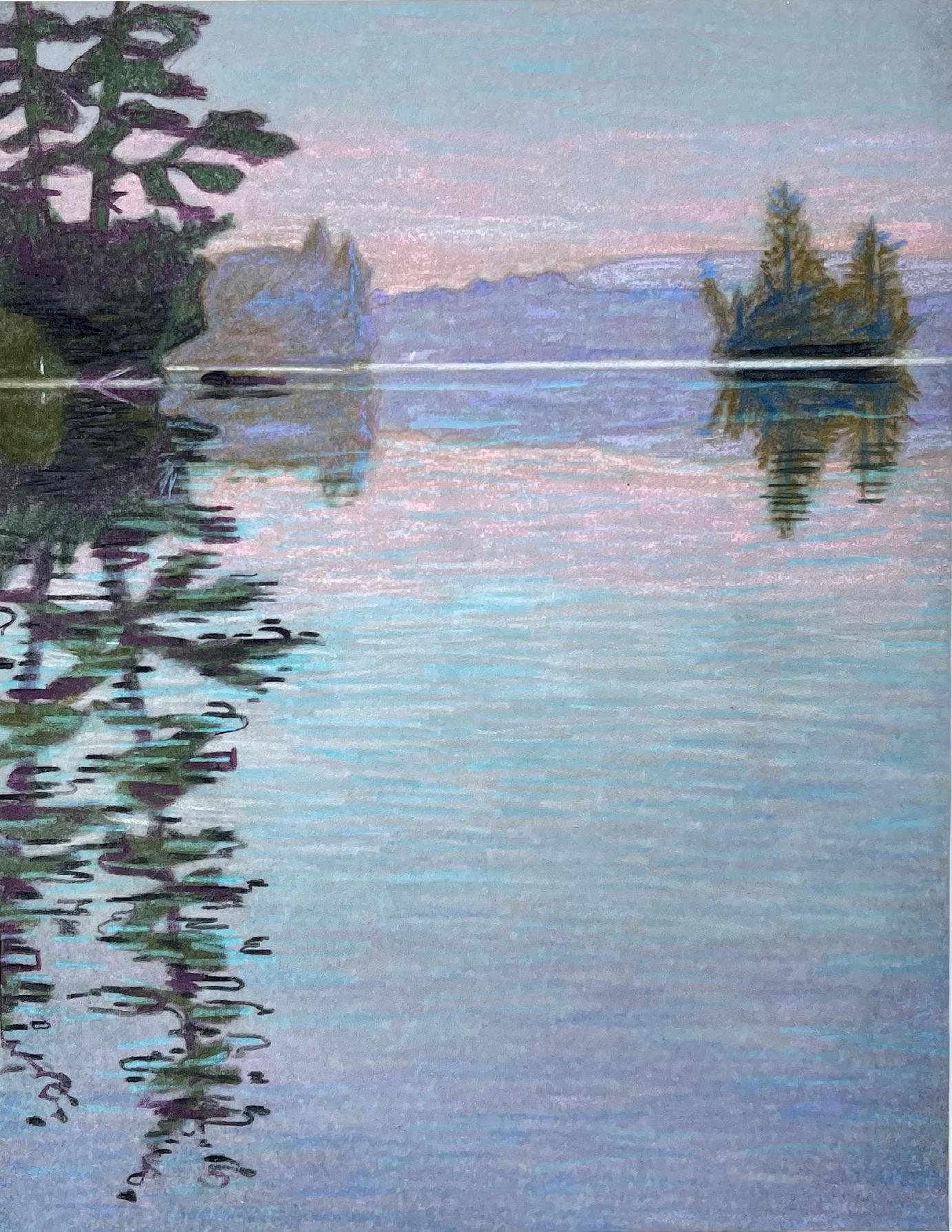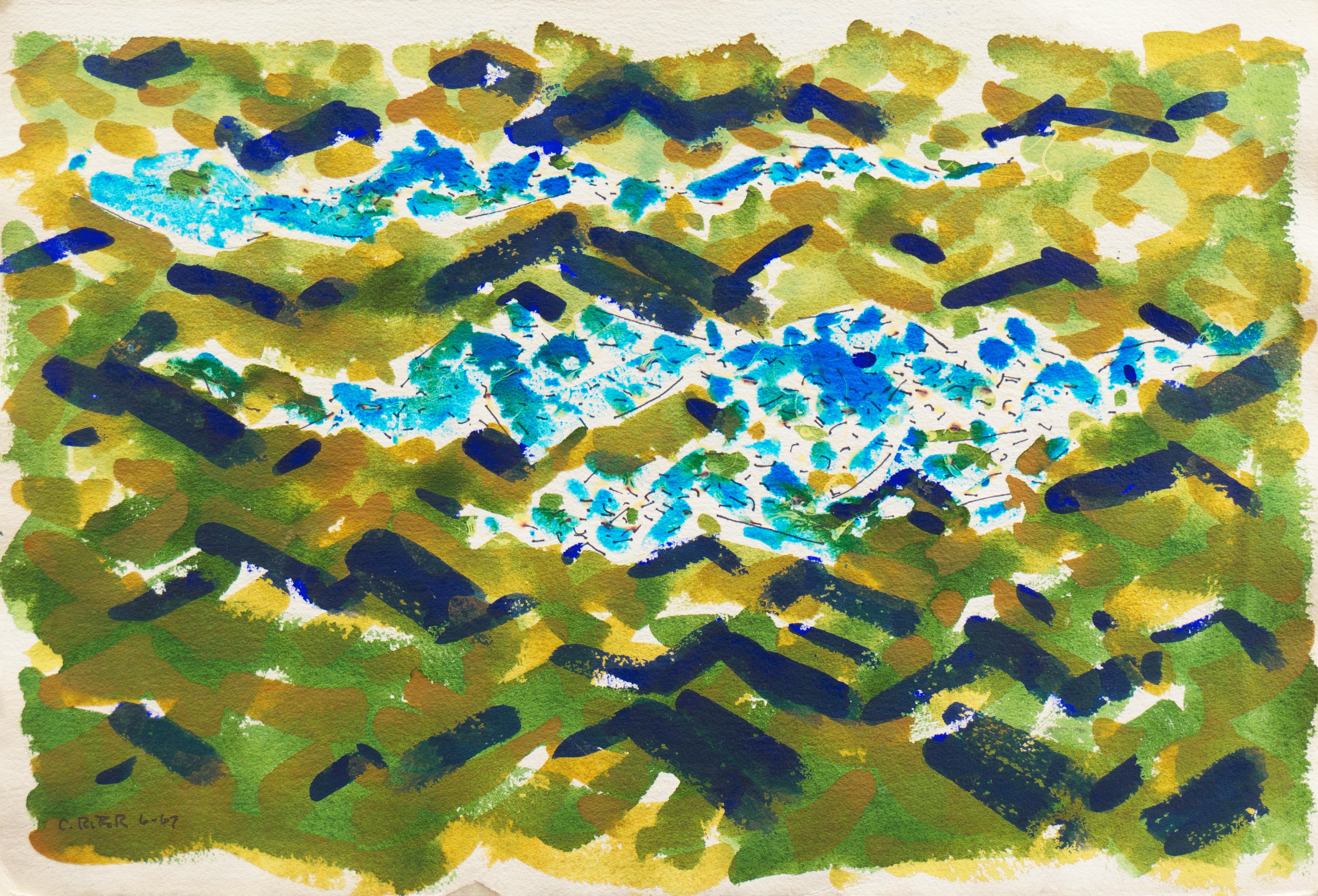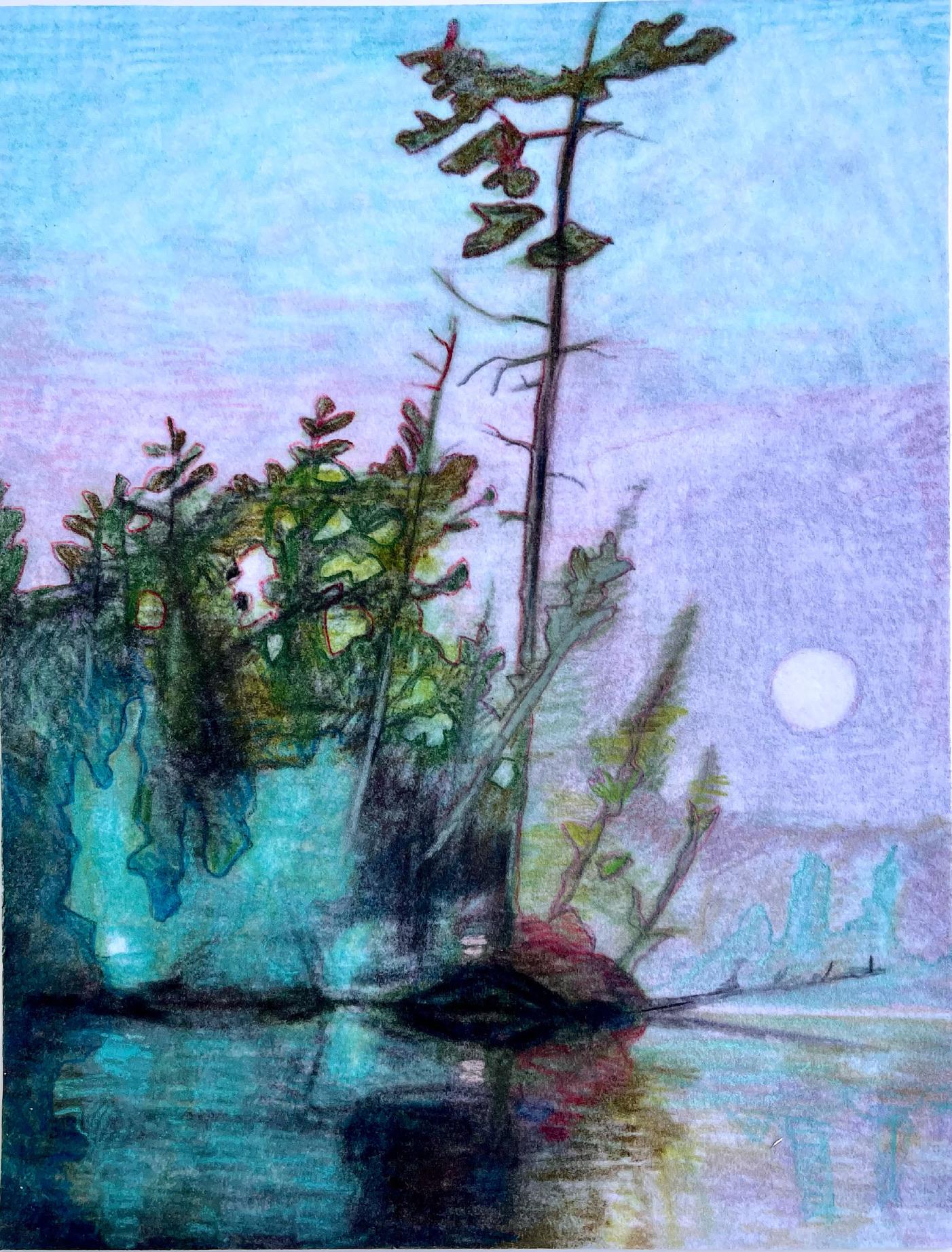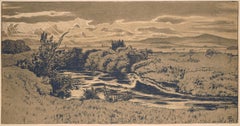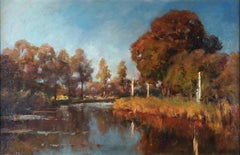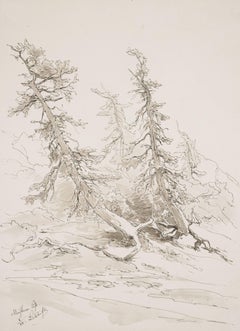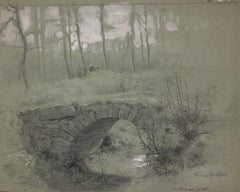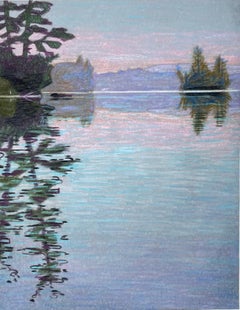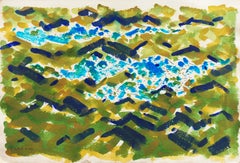Items Similar to Lonely and lively lake / - Calm and Movement -
Want more images or videos?
Request additional images or videos from the seller
1 of 8
Reinhard StanglLonely and lively lake / - Calm and Movement -1985
1985
$938.61
£694.90
€780
CA$1,299.57
A$1,418.82
CHF 743.83
MX$17,232.13
NOK 9,289.23
SEK 8,771.51
DKK 5,938.31
About the Item
Reinhard Stangl (*1959 Leipzig), Lonely and lively lake, 1985. White heightened blue colored pencil drawings on brown paper, each 21 cm x 29 cm, signed lower right and once dated 1985.
- in very good condition
- Calm and Movement -
The first picture shows a calm bay, while the second shows the same part of the lake bustling with bathers. The bustling part will eventually return to a calm state. We are not bathers ourselves but rather observe the alternation of calm and movement from a superior perspective, lending the repetitive sequence a sense of timelessness.
In the first painting, the brown ground forms a still surface of water framed by a blue landscape. White clouds gather in the distance above it. It is precisely the white that brings dynamism to the scenery. White waves form on the water's surface, and the water appears whitish from the bathers running into it. Similarly, white structures crisscross the sky, suggesting that not only are the people in the lake moving, but the entire landscape is also dynamic. This is particularly evident in contrast to the bathers lying on the shore in front, who are integrated into the landscape.
About the artist
Reinhard Stangl studied painting at the Dresden Academy of Fine Arts from 1972 to 1977. He then moved to Berlin-Lichtenberg. In 1980, he left East Germany and moved to West Berlin. From then on, he worked as a freelance artist. He co-founded the First Berlin Summer Academy and held various guest professorships. In 1999, he withdrew his work from the "Rise and Fall of Modernism" exhibition as part of the "Weimar Picture Controversy." Artists from the GDR considered their work to be propaganda. Stangl's design won the competition for the “Memorial to the Murdered Jews of Europe” in Berlin. However, following an objection by German Chancellor Helmut Kohl, a new competition was held, and Peter Eisenman's design was chosen.
Stangl's works have been exhibited regularly since the 1980s and can be found in numerous public collections.
GERMAN VERSION
Reinhard Stangl (*1959 Leipzig), Einsamer und belebter See, 1985. Weiß gehöhte blaue Buntstiftzeichnungen auf braunem Papier, jeweils 21 cm x 29 cm, unten rechts handsigniert und einmal auf 1985 datiert.
- in sehr gutem Zustand
- Ruhe und Bewegung -
Zeigt das erste Bild eine ruhig daliegende Bucht, so veranschaulicht die zweite Darstellung dieselbe von Badegästen belebte Stelle des Sees, wobei der belebte wieder in den ruhigen Zustand übergehen wird. Da wir beide Zustände betrachten, gehören wir selbst nicht zu den Badegästen, sondern beobachten den Wechsel von Ruhe und Bewegung aus einer übergeordneten Perspektive, was der sich wiederholenden Abfolge etwas Zeitloses verleiht.
Auf dem ersten Bild bildet der braune Malgrund den unbewegten von der blauen Landschaft eingefassten Wasserspiegel, über dem sich in der Ferne weiße Wolken sammeln. Gerade das Weiß trägt auf dem belegten Bild die Dynamik in die Szenerie. Auf der Wasserfläche bilden sich weiße Wellen und das Wasser spitzt vom Hineinrennen der Badenden weißlich auf. Analog dazu ist der Himmel von weißen Strukturen durchzogen, so dass nicht allein die Menschen im See bewegt sind, sondern die ganze Landschaft dynamisiert ist, was durch den Kontrast zu den am vorderen Ufer liegenden in die Landschaft integrierten Badegästen besonders zutage tritt.
zum Künstler
Reinhard Stangl studierte von 1972 bis 1977 Malerei an der Hochschule für Bildende Künste Dresden und zog anschließend nach Berlin-Lichtenberg. 1980 verließ er die DDR und siedelte nach Berlin-Kreuzberg um. Fortan war Stangl als freischaffender Künstler tätig. Er war Mitbegründer der Ersten Berliner Sommerakademie und hatte verschiedene Gastprofessuren inne. 1999 zog er im Rahmen des ‚Weimarer Bilderstreits‘ seine Werke von der Ausstellung ‚Aufstieg und Fall der Moderne‘ zurück. Aus der DDR stammende Künstler sahen ihre Werke als Propaganda inszeniert. Beim Wettbewerb für das ‚Denkmal für die ermordeten Juden Europas‘ in Berlin gewann der Entwurf, an dem Stangl beteiligt war. Auf den Einspruch des Bundeskanzlers Helmut Kohl wurde jedoch ein neuer Wettbewerb ausgelobt und der Entwurf von Peter Eisenman realisiert.
Werke Reinhard Stangls befinden sich in zahlreichen öffentlichen Sammlungen und werden seit den 80er Jahren regelmäßig ausgestellt.
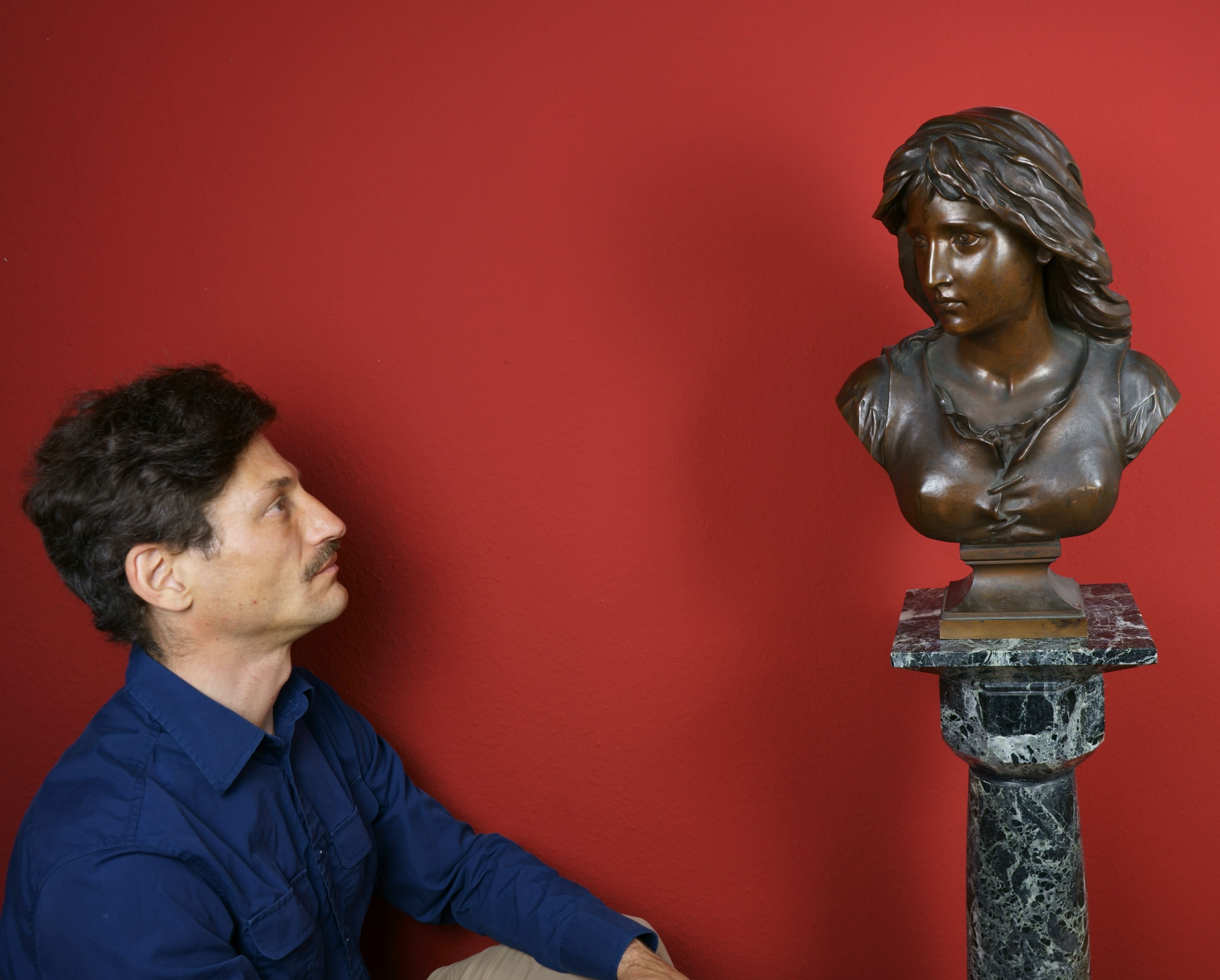
About the Seller
5.0
Vetted Professional Seller
Every seller passes strict standards for authenticity and reliability
Established in 2014
1stDibs seller since 2023
21 sales on 1stDibs
- ShippingRetrieving quote...Shipping from: Berlin, Germany
- Return Policy
Authenticity Guarantee
In the unlikely event there’s an issue with an item’s authenticity, contact us within 1 year for a full refund. DetailsMoney-Back Guarantee
If your item is not as described, is damaged in transit, or does not arrive, contact us within 7 days for a full refund. Details24-Hour Cancellation
You have a 24-hour grace period in which to reconsider your purchase, with no questions asked.Vetted Professional Sellers
Our world-class sellers must adhere to strict standards for service and quality, maintaining the integrity of our listings.Price-Match Guarantee
If you find that a seller listed the same item for a lower price elsewhere, we’ll match it.Trusted Global Delivery
Our best-in-class carrier network provides specialized shipping options worldwide, including custom delivery.More From This Seller
View AllAt the pond / - The longing of the landscape -
Located in Berlin, DE
Hans Thoma (1839 Bernau - 1924 Karlsruhe), At the pond, 1897. Algraph on strong wove paper, published by Breitkopf und Härtel in Leipzig as ‘Zeitgenössisches Kunstblatt Nr. 148’, 23....
Category
1890s Realist Figurative Prints
Materials
Paper
Late Summer River Landscape / - Realistic Impression -
By Jan Hillebrand Wijsmüller
Located in Berlin, DE
Jan Hillebrand Wijsmuller (1855 Amsterdam - 1925 ibid.), Late Summer River Landscape, oil on canvas, relined, 34 x 56 cm (inside measurement), 43 x 64 cm (frame), signed J[an] H[illebrand] Wijsmuller at lower right.
- in good condition, the frame with isolated bumped spots
- Realistic Impression -
About the artwork
The panoramic landscape format shows a river landscape, with the course of the river, which curves to the right, leading the eye into the depths of the picture and tempting it to continue the landscape in the imagination beyond the visible area. At the same time, however, the fact that the landscape is not visible through the bend in the river focuses our gaze on the entirety of the landscape depicted, without prompting us to focus on distant details. Accordingly, the brushstroke is not designed to render details with realistic precision. In the front left area of the river there is even a completely free brushwork, trained by Impressionism, which nevertheless remains committed to representational and convincingly suggests the movement of the water.
Regardless of the distance of the observer, the entire picture is painted with the same broad brushstroke, so that the landscape is given as an impression. And yet this impression is not ephemeral, as in the case of French Impressionism, to put it exaggeratedly, but reveals to us the essence of the landscape in all its richness. This is why the Dutch variant of Impressionism is always also a realism, although the pictures appear less progressive, but still contain a dimension of landscape painting that is lost with progress.
In the impression, the reality of the landscape is revealed, and this happens as we experience the landscape in the visual impression. Wijsmuller does not depict houses or people in order to allow the experience of the landscape to fully unfold. The experience is determined first and foremost by the river, which does not flow into the picture from our point of view, but towards us. Where the river begins to bend, the water is churned by a rapids. Toward us, the riverbed widens and the water comes to rest, covering the entire width of the foreground like a mirror.
The stillness of the water corresponds to the evening mood of the late summer landscape, in which the warm tones of the evening light blend with the yellow and brown tones of the plants. A gentle, almost idyllic reality, carried by the brushstroke, yet animated by a liveliness that is also made visible by the brushstroke. The broad, dynamically placed brushstrokes evoke the movement of the treetops and animate even the immobile reeds, while the trunks on the right bank, executed in virtuoso white strokes that seem like markings, make the sunlight shine. On the other bank, a carpet of light also spreads out, its energetic effect again expressed in the brushstroke. The dynamic of the landscape is further enhanced by the complementary color contrasts between the greens, yellows, and browns on the one hand and the blue of the all-encompassing sky on the other. A contrast that is intensified by the reflection in the water.
The evening coming to rest of the landscape is thus at the same time an all-encompassing contrasting and yet in itself harmonious movement. This reality becomes accessible to us as an experience in the impression of the landscape.
About the artist
Jan Hillebrand Wijsmuller entered the Royal Academy of Arts in Amsterdam in 1876 and studied under the innovative Professor August Allebé, who was famous for the Amsterdam Impressionism, also known as the Allebé School.
In 1877, Wijsmuller transferred to the Hague Academy of Art, and thus to the Hague School, and then completed his studies at the Brussels Academy of Art. Returning to the Netherlands, Wijsmuller opened his own studio in Amsterdam.
In 1883 he won the prestigious Young Artist Award, donated by Willink van Collen, which made Wijsmuller a well-known and sought-after artist.
Wijsmuller was a member of the Societät Arti et Amicitiae Amsterdam and the Pulchri Studio in The Hague.
Wijsmuller belongs to the second generation of the Hague School. While Vincent van Gogh described the protagonists of the first generation to his brother Theo as "the great gray people," the second generation, and Wijsmuller in particular, used a much more colorful palette. His oeuvre makes him a major player in Dutch Impressionism...
Category
1890s Impressionist Landscape Paintings
Materials
Canvas
$3,658 Sale Price
20% Off
Woodland / - The Inner Drama of the Landscape -
Located in Berlin, DE
Eduard Peithner von Lichtenfels (1833 Vienna - 1913 Berlin), Woodland, 1884. Watercolor and pen and ink on drawing paper, 30.4 cm x 22.5 cm, signed, dated and inscribed by the artist...
Category
1880s Landscape Drawings and Watercolors
Materials
Paper
In the forest of Durlach - Quiet ripple in a secret place -
Located in Berlin, DE
Franz Xaver Graessel (1861 Oberasbach/Baden - 1948 Emmering). In the forest of Durlach. 1881. Pencil drawing, heightened with white, on grey-green paper. 33 x 41.7 cm. Signed, dated and inscribed by the artist himself: 'Franz Graessel. Durlach, 12 April 1881".
About the artwork
The drawing depicts a view of the woods which, as if sharpening the visual focus, remains diffuse at the edges and does not allow the viewer to locate himself in the picture. As a result, the landscape appears to be an apparition, but at the same time it is given real substance by the solidity of the massive arched bridge made of quarry stone. As the main motif of the painting, the bridge, which blends in with nature like an archaic relic, also acts as a visual guide, drawing attention to the white, raised waters of the stream and the surrounding vegetation. The diffusion of perception that takes place there, however, draws the eye back to the bridge and thus to the overall view. This movement initiating a constant alternation of diffusion and concretion, which is the specific tension of the painting that brings the landscape to life. The materialisation and dematerialisation, however, does not take place solely through the eye's wandering through the picture; it is simultaneously linked to the viewer's approach to and distance from the picture, which loses its richness of detail precisely in the close-up, only to reconfigure itself with increasing distance.
In this work, which dates from Graessel's studies in Karlsruhe, the artist reflects on the emergence of pictorial objectivity. Here, however, nature is more than a mere motif. The real connection between culture and nature is symbolically expressed by the choice of green paper.
The drawing is an impressive testimony to Graessel's mastery of the sprezzatura with which he skilfully applies the most abstract of strokes, which visibly merge towards the centre of the picture. The signature and the exact date prove that Graessel gave this work more than the character of a mere sketch.
About the artist
Franz Graessel grew up in an environment that was to nourish his later key motifs: his parents' house was a mill. After attending the Karlsruhe Academy of Art from 1878 to 1884, where he studied under Carl Hoff, Graessel continued his training at the Munich Academy from 1886 to 1890 as a pupil of Wilhelm von Lindenschmidt. Trained primarily in genre and portrait painting, he initially portrayed the life of Black Forest farmers. From 1894 he turned increasingly to animal painting, concentrating on the depiction of ducks and geese, which earned him the nickname 'Enten-Graessel'. Graessel's work thus parallels that of Alexander Koester...
Category
1880s Naturalistic Landscape Drawings and Watercolors
Materials
Chalk, Pencil, Paper
$2,310 Sale Price
20% Off
Landscape verso Forest interior / - Landscape as a space of imagination -
Located in Berlin, DE
Herbert Seidel (1906 Berlin - 1974 Rüdersdorf), Landscape verso Forest interior, around 1950. India ink on grained, bleached paper, 40.5 x 58 cm, signed “Herbert Seidel” in pencil on...
Category
1950s Abstract Landscape Drawings and Watercolors
Materials
Paper
Evening - The depth of the visible -
Located in Berlin, DE
Max Clarenbach (1880 Neuss - Cologne 1952), Evening. Etching, 18 x 41 cm (platemark), 33.5 x 57 cm (frame), inscribed "Abend" in pencil at lower left, signed and dated "M. Clarenbach. 28.III.[19]09". Framed and mounted under glass.
- Somewhat browned and slightly foxed.
About the artwork
The horizontally elongated etching depicts the panoramic view of a small town as seen from the other side of the river. There are gabled houses on the left and a mighty church spire on the right. The bourgeois houses and the large religious building indicate the urban character. These buildings are rendered in dark tones to emphasise the lighter row of houses in the centre of the picture, closer to the water. The chiaroscuro contrast creates two parallel planes that open up a space for the imagination of what the city could be. The imagination is stimulated by the almost entirely dark, barely recognisable buildings, while the arm of the river leading into the city further stimulates the imagination.
However, as the silhouette of the city as a whole is reflected in the water, the parallel planes are perceived as a band of houses that stretches across the entire horizontality of the etching and seems to continue beyond the borders of the picture. The reflection has almost the same intensity as the houses themselves, so that the band of buildings merges with their reflection to form the dominant formal unit of the picture. Only the parallel horizontal hatching creates the convincing impression of seeing water, demonstrating Max Clarenbach's mastery of the etching needle.
The water is completely motionless, the reflection unclouded by the slightest movement of the waves, creating a symmetry within the formal unity of the cityscape and its reflection that goes beyond the motif of a mere cityscape. A pictorial order is established that integrates everything in the picture and has a metaphysical character as a structure of order that transcends the individual things. This pictorial order is not only relevant in the pictorial world, but the picture itself reveals the order of the reality it depicts. Revealing the metaphysical order of reality in the structures of its visibility is what drives Clarenbach as an artist and motivates him to return to the same circle of motifs.
The symmetry described is at the same time inherent an asymmetry that is a reflection on art: While the real cityscape is cut off at the top of the picture, two chimneys and above all the church tower are not visible, the reflection illustrates reality in its entirety. The reflection occupies a much larger space in the picture than reality itself. Since antiquity, art has been understood primarily as a reflection of reality, but here Clarenbach makes it clear that art is not a mere appearance, which can at best be a reflection of reality, but that art has the potential to reveal reality itself.
The revealed structure of order is by no means purely formalistic; it appears at the same time as the mood of the landscape. The picture is filled with an almost sacred silence. Nothing in the picture evokes a sound, and there is complete stillness. There are no people in Clarenbach's landscape paintings to bring action into the picture. Not even we ourselves are assigned a viewing position in the picture, so that we do not become thematic subjects of action. Clarenbach also refrains from depicting technical achievements. The absence of man and technology creates an atmosphere of timelessness. Even if the specific date proves that Clarenbach is depicting something that happened before his eyes, without the date we would not be able to say which decade, or even which century, we are in. The motionless stillness, then, does not result in time being frozen in the picture, but rather in a timeless eternity that is nevertheless, as the title "Abend" (evening), added by Clarenbach himself, makes clear, a phenomenon of transition. The landscape of the stalls is about to be completely plunged into darkness, the buildings behind it only faintly discernible. The slightly darkened state of the sheet is in keeping with this transitional quality, which also lends the scene a sepia quality that underlines its timelessness. And yet the depiction is tied to a very specific time. Clarenbach dates the picture to the evening of 28 March 1909, which does not refer to the making of the etching, but to the capture of the landscape's essence in the landscape itself.
If the real landscape is thus in a state of transition, and therefore something ephemeral, art reveals its true nature in that reality, subject to the flow of phenomena, is transferred to an eternal moment, subject to a supra-temporal structure of order - revealed by art. Despite this supratemporality, the picture also shows the harbingers of night as the coming darkening of the world, which gives the picture a deeply melancholy quality, enhanced by the browning of the leaf.
It is the philosophical content and the lyrical-melancholic effect of the graphic that give it its enchanting power. Once we are immersed in the image, it literally takes a jerk to disengage from it.
This etching, so characteristic of Max Clarenbach's art, is - not least because of its dimensions - a major work in his graphic oeuvre.
About the artist
Born into poverty and orphaned at an early age, the artistically gifted young Max Clarenbach was discovered by Andreas Achenbach and admitted to the Düsseldorf Art Academy at the age of 13.
"Completely penniless, I worked for an uncle in a cardboard factory in the evenings to pay for my studies.”
- Max Clarenbach
At the academy he studied under Arthur Kampf, among others, and in 1897 was accepted into Eugen Dücker...
Category
Early 1900s Realist Landscape Prints
Materials
Etching
$558 Sale Price
20% Off
You May Also Like
Impressionist Lake - Original Signed Charcoals Drawing
By Gaston Coppens
Located in Paris, IDF
Gaston COPPENS (1909 - 2002)
Impressionist Lake
Original charcoal drawing
Handsigned on the bottom right of the sheet
On canson paper, 50 x 65 cm (c. 19,6 x 25,5 inch)
Very good co...
Category
Mid-20th Century Modern Landscape Drawings and Watercolors
Materials
Charcoal
Pond #4
By Ursula Schneider
Located in San Francisco, CA
This artwork titled "Pond #4" 1984 is an original soft pastel on paper by Swiss/American artist Ursula Schneider, b.1943. It is unsigned. The artwork size is 15 x 22 inches, framed size is 17.25 x 24.5 inches. Custom framed in a black metal frame. It is in excellent condition.
About the artist:
The work of Ursula Schneider include pastel drawings, paintings, small-scale sculptural paintings and woodcuts, working on one medium at a time. These processes complement and enrich each other by stimulating a fresh approach and allowing for experimentation. Drawing from observation in the landscape has been the basis for the work.
She attended Kunstgewerbeschule in Zurich and Keramische Fachschule in Bern and holds an Undergraduate Degree in Ceramics from Switzerland.
In 1968 she moved to the United States and graduated in 1972 with an MFA in Painting from the San Francisco Art Institute.
She lived and worked in New York from 1980-2004 and taught painting at the San Francisco Art Institute, Cooper Union and Sarah Lawrence College.
Grants And Awards:
1985 National Endowment for the Arts. Major Fellowship Grant
1976 San Francisco Art Festival Award
1974 The Oakland Museum. The New Talent Award
1968 Swiss Government Grant: Kunststipendium
Selected Solo Exhibitions:
Kunstmuseum Bern Switzerland
UC Art Museum Berkley, CA
Oakland Museum, CA
Forum Febicus, Switzerland
Selected Group Exhibitions:
Museum of Fine Arts, Forth Worth, TX
Biennial Exhibition Whitney Museum, NY
San Francisco Museum, CA
Los Angeles Institute of Contemporary Art, CA
Rockland Center for the Arts, NY.
Collections:
UC Berkley Art Museum,
Di Rosa Preserve in CA,
U.S. Department of State,
Auditorium Netzwerk, Germany,
The Union Bank of Switzerland,
UBS Security,
Bell Savings Art Plus,
Security Pacific Bank, CA,
Swiss Bank...
Category
Late 20th Century Modern Landscape Drawings and Watercolors
Materials
Pastel
Lake 3 (kayak), post-impressionistic landscape drawing
By Sandy Litchfield
Located in New York, NY
Sandy Litchfield finds the consummate marriage of medium and subject in her latest enchanted landscapes. She narrows her focus to lake scenes, creating an almost palindrome-like comp...
Category
2010s Post-Impressionist Landscape Drawings and Watercolors
Materials
Synthetic Paper, Color Pencil
'Abstracted Lake Landscape', Wisconsin artist
Located in Santa Cruz, CA
Signed lower left, 'C. Riter' for Carl Frederick Riter (American, born. 1915) and dated '6-'67'.
Stamped verso with certification of authenticity...
Category
1960s Landscape Drawings and Watercolors
Materials
Paper, Glue, Watercolor, Gouache, Pen
Reflective Lake
Located in Houston, TX
Lovely watercolor of reflective lake with highlights of purple by French artist A. Prompt, circa 1960. Signed lower right.
Original artwork on paper displayed on a white mat with ...
Category
1960s Landscape Drawings and Watercolors
Materials
Watercolor
Lake 1 (kayak), post-impressionistic landscape drawing
By Sandy Litchfield
Located in New York, NY
Sandy Litchfield finds the consummate marriage of medium and subject in her latest enchanted landscapes. She narrows her focus to lake scenes, creating an almost palindrome-like comp...
Category
2010s Post-Impressionist Landscape Drawings and Watercolors
Materials
Synthetic Paper, Color Pencil
More Ways To Browse
Tide Figure
Vintage Las Vegas Showgirls
Watercolour Antique Pre 1900 Paintings
Zero Mostel
Zuniga Pastel
Betty Rees Heredia
Blair Hobbs
Breastfeeding Painting
Carl Fredrik Reutersward
Conger Metcalf
Dora Carrington
Drawings And Watercolor Indonesia
E Nevil
Ellsworth Young
Embracing Nude Figures
Emma Jones
Frederick Philips
Gad Ullman
